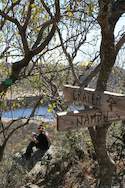Vredefort Dome Structure

The complete Vredefort Dome structure extends over a circular area with a diameter of 300 km. It stretches from above Johannesburg in the north east to Welkom in the south west. At the approximate centre of the Dome is a small town called Vredefort.
The World Heritage site, however, is restricted to a core zone located 120 km south west of Johannesburg, on the banks of the Vaal River. This ‘Dome Mountain Land’ is the remainder of a central uplift that used to stand in the middle of the original crater.
Here, the Archaean granite dome and its surrounding collar of overturned rocks have been eroded to form a scenic series of parallel ridges and valleys, curving in a graceful arc between Vredefort, Parys and Potchefstroom.
These urban centres are on the periphery but are not part of the core zone, so that development of the towns will not be hindered by protective heritage legislation.
Boundaries of the Core Zone
The boundaries of the core zone roughly correspond to several roads linking these three towns. The eastern border is Parys-Potch tar road (R53). The Schoemansdrift-Potch road (part tar-part gravel) is on the western edge.
A gravel road running east to west (called the Schoemansdrift Road) connects the two Potch-ward roads on the North West Province side. And, in the south, there are several gravel roads that make a half-moon shape on the Free State side. Around this square-ish core zone there is a buffer zone of 5 kilometers.
Through the middle of the Dome region runs the Vaal (meaning ‘tawny’ or ‘dusty’) River, flowing from east to west. The Vaal is a major waterway by South African standards and helps supply Joburg and the surrounding industrial complex with water. Most of this industrial activity takes place upstream from the Dome, in the towns of Sasolburg, Vanderbijlpark and Vereeniging.
The Vaal River is also popular as a water sports destination, offering fishing, sailing, water skiing, kayaking and even some white water rafting. The Vaal Dam, upstream from Vereeniging, is another well established vacation area.
Turbulent Topography
Because of the turbulent topography of the Dome Mountain Land, the flow of the usually broad and flat Vaal River is disturbed as it channels through the inclined rock layers. This causes the water to speed up and divide into a number of streams and rapids, separated from each other by hundreds of small islands.
The largest of these islands is 150ha, and another contains a 9-hole golf course. This latter island, appropriately called Golf Island, is linked to Parys by a nice little suspension bridge. The islands of the Vaal harbour a wealth of animals, plants and birdlife.
They also used to contain human squatters and other undesirables, particularly around the Parys area where the islands are large and numerous. During the 2nd Anglo-Boer War, these islands were further inhabited by fugitives and deserters who snuck across the river and hid in the thick vegetation.
The thing was, the islands were neutral territory; a no-mans land that didn’t belong to either the Orange Free State or the Transvaal.
Play Nice
In the late 1800s, this situation was challenged by the two republics, who both claimed that the islands belonged to them. A long legal battle ensued to try and work out which islands belonged to whom. In the end, a special committee was set up to survey each island and thereafter grant it to the one state or the other.
Sensibly, the islands were not allowed to be split down the middle. In 1895, the ‘Vaal River Island Treaty’ was signed. The Transvaal had scored 100 islands and the Free State got 90. Now that’s what I call a negotiated settlement! Today, the Vaal River marks the boundary between the North West Province and the Free State Province.
The Dome therefore straddles two provincial authorities and this has made its development and marketing a bit tricky. Furthermore, the Dome core area includes well over 100 privately-owned farms and several district municipalities.
One hopes that everyone will be able to play nice and allow the potential of the Dome to come to fruition. Please note, however, that many of the Dome’s attractions are currently on private land and may not be visited without the permission of the land owner.
By David Fleminger Driving through the Vredefort Dome. The gateway to the Vredefort Dome is Parys, an attractive holiday town built along the south bank of the...
Driving through the Vredefort Dome. The gateway to the Vredefort Dome is Parys, an attractive holiday town built along the south bank of the... The Vredefort Dome is situated in the Grasslands biome, on the cusp between the Highveld and the Transvaal plateau. The grass type is usuall...
The Vredefort Dome is situated in the Grasslands biome, on the cusp between the Highveld and the Transvaal plateau. The grass type is usuall... Although the town of Vredefort gave its name to the Dome, there is little else to attract visitors to this quiet village. It was founded aro...
Although the town of Vredefort gave its name to the Dome, there is little else to attract visitors to this quiet village. It was founded aro...